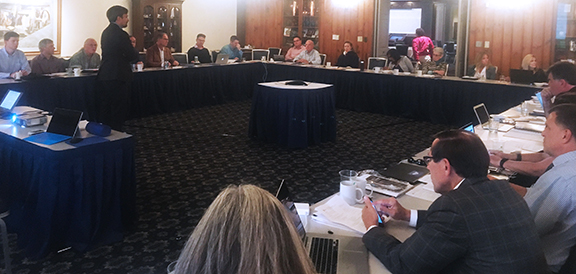IMAGE OF THE WEEK

Penn State’s Online Geospatial Education Advisory Board met at The Nittany Lion Inn on August 28. The board provides an annual evaluation of the MGIS degree and our geospatial education certificate programs. The Advisory Board also provides strategic advice on how the programs can best respond to the needs of geospatial professionals and society.
GOOD NEWS

- Jennifer Baka’s son, Theodore Henry Baka Lewellen, pictured at right, was born on September 7.
- Sam Stehle successfully defended his dissertation on August 17. He started his post-doc at Maynooth University near Dublin, Ireland.
- Alumnus Mark Read assumed duties as the Head of the Department of Geography and Environmental Engineering, one of the 13 academic departments here at the U.S. Military Academy.
- Cindy Zook will be at Pop Up Ave on Saturday, September 23, selling her handmade Goat’s Milk Soap, Super Concentrated Body Butter, and a few Fair Trade African Baskets.
- DigitalGlobe, is providing free before/after satellite imagery of areas affected by Hurricane Irma/Jose, from the eastern Caribbean through South Carolina. They have posted the before imagery already, and you can get updates here: https://www.digitalglobe.com/opendata/hurricane-irma/pre-event. Digital Globe is also sponsoring a crowdsourcing imagery analysis and mapping effort to support recovery from Hurricane Harvey. You can access that program here: http://www.tomnod.com/
NEWS
- 3:30 to 5:00 p.m.: Refreshments are offered in 319 Walker Building at 3:30 p.m.; the lecture begins in 112 Walker Building at 4:00 p.m.
- Next week: Don McCandless, Director, Business Development, Ben Franklin Transformation Services
Online Geospatial Education Student Focus: Augustus Wright
We enjoy hearing from our talented students in the Penn State Online Geospatial Program, especially about what they have learned from our classes and how they plan to apply their certificate/degree.
Chief Warrant Officer 3 Augustus Wright, from Fort Leonard Wood, Missouri, entered our program in 2015 and just earned his MGIS degree this past Spring. For his capstone project, he studied machine learning algorithms and their applications to geospatial technology (a more detailed summary of his project is at the end of this note).
Chief Wright has served three combat deployments to Iraq and earned two Bronze Star Medals, among several other awards. We are proud of him and all of the veteran and current military students in our program.
Flying down to Rio
Students use digital technology to explore design solutions for Brazilian favela
As the world’s population grows, so does the problem of affordable housing. In some rapidly growing urban areas, particularly in developing countries, the only recourse is to build your own.
The informal settlements that pop up on the edges of many modern cities are often derided as problem areas or slums, ramshackle neighborhoods beset with sanitation issues and crime. To Jose Duarte, however, they are “not a problem to be solved, but a solution that has some problems.”
Brooks elected Fellow of the Society of Wetland Scientists
Robert Brooks, Ruby S. and E. Willard Miller Professor of Geography and Ecology and director of Riparia, was elected a Fellow of the Society of Wetland Scientists, the society’s highest honor, during a ceremony in San Juan, Puerto Rico, in June.
Brooks is a nationally recognized leader in wetland science and policy with more than 35 years of experience in education and research related to inland freshwater wetlands and riverine ecosystems.
PUBLISHED RECENTLY/PRESENTLY
A regional assessment of white-tailed deer effects on plant invasion
By KM Averill, DA Mortensen, EAH Smithwick, S Kalisz, and others
In Annals of Botany Plants, 2017
Access: doi.org/10.1093/aobpla/plx047
Herbivores can profoundly influence plant species assembly, including plant invasion, and resulting community composition. Population increases of native herbivores, e.g., white-tailed deer (Odocoileus virginianus), combined with burgeoning plant invasions raise concerns for native plant diversity and forest regeneration. While individual researchers typically test for the impact of deer on plant invasion at a few sites, the overarching influence of deer on plant invasion across regional scales is unclear. We tested the effects of deer on the abundance and diversity of introduced and native herbaceous and woody plants across 23 white-tailed deer research sites distributed across the east central and northeastern United States and representing a wide range of deer densities and invasive plant abundance and identity.
